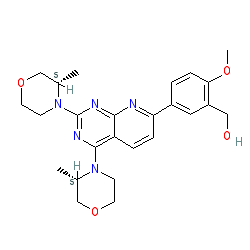GtoPdb is requesting financial support from commercial users. Please see our sustainability page for more information.
|
Synonyms: AZD 8055 | AZD-8055
Compound class:
Synthetic organic
Comment: AZD8055 is an inhibitor of the mammalian target of rapamycin (mTOR) kinase [1]. AZD8055 was investigated as a potential treatment for various types of relapsed and/or refactory cancer. This compound is now included in AstaZeneca's Open Innovation Pharmacology Toolbox.
Ligand Activity Visualisation ChartsThese are box plot that provide a unique visualisation, summarising all the activity data for a ligand taken from ChEMBL and GtoPdb across multiple targets and species. Click on a plot to see the median, interquartile range, low and high data points. A value of zero indicates that no data are available. A separate chart is created for each target, and where possible the algorithm tries to merge ChEMBL and GtoPdb targets by matching them on name and UniProt accession, for each available species. However, please note that inconsistency in naming of targets may lead to data for the same target being reported across multiple charts. ✖ |
|
|||||||||||||||||||||||||||||||||||
| References |
|
1. Chresta CM, Davies BR, Hickson I, Harding T, Cosulich S, Critchlow SE, Vincent JP, Ellston R, Jones D, Sini P et al.. (2010)
AZD8055 is a potent, selective, and orally bioavailable ATP-competitive mammalian target of rapamycin kinase inhibitor with in vitro and in vivo antitumor activity. Cancer Res, 70 (1): 288-98. [PMID:20028854] |
|
2. Datan E, Shirazian A, Benjamin S, Matassov D, Tinari A, Malorni W, Lockshin RA, Garcia-Sastre A, Zakeri Z. (2014)
mTOR/p70S6K signaling distinguishes routine, maintenance-level autophagy from autophagic cell death during influenza A infection. Virology, 452-453: 175-90. [PMID:24606695] |
|
3. Dittmar M, Lee JS, Whig K, Segrist E, Li M, Kamalia B, Castellana L, Ayyanathan K, Cardenas-Diaz FL, Morrisey EE et al.. (2021)
Drug repurposing screens reveal cell-type-specific entry pathways and FDA-approved drugs active against SARS-Cov-2. Cell Rep, 35 (1): 108959. [PMID:33811811] |
|
4. Fabrizio P, Pozza F, Pletcher SD, Gendron CM, Longo VD. (2001)
Regulation of longevity and stress resistance by Sch9 in yeast. Science, 292 (5515): 288-90. [PMID:11292860] |
|
5. Harrison DE, Strong R, Sharp ZD, Nelson JF, Astle CM, Flurkey K, Nadon NL, Wilkinson JE, Frenkel K, Carter CS et al.. (2009)
Rapamycin fed late in life extends lifespan in genetically heterogeneous mice. Nature, 460 (7253): 392-5. [PMID:19587680] |
|
6. Pike KG, Malagu K, Hummersone MG, Menear KA, Duggan HM, Gomez S, Martin NM, Ruston L, Pass SL, Pass M. (2013)
Optimization of potent and selective dual mTORC1 and mTORC2 inhibitors: the discovery of AZD8055 and AZD2014. Bioorg Med Chem Lett, 23 (5): 1212-6. [PMID:23375793] |
|
7. Robida-Stubbs S, Glover-Cutter K, Lamming DW, Mizunuma M, Narasimhan SD, Neumann-Haefelin E, Sabatini DM, Blackwell TK. (2012)
TOR signaling and rapamycin influence longevity by regulating SKN-1/Nrf and DAF-16/FoxO. Cell Metab, 15 (5): 713-24. [PMID:22560223] |
|
8. Sarbassov DD, Ali SM, Kim DH, Guertin DA, Latek RR, Erdjument-Bromage H, Tempst P, Sabatini DM. (2004)
Rictor, a novel binding partner of mTOR, defines a rapamycin-insensitive and raptor-independent pathway that regulates the cytoskeleton. Curr Biol, 14 (14): 1296-302. [PMID:15268862] |
|
9. Yang Z, Klionsky DJ. (2010)
Mammalian autophagy: core molecular machinery and signaling regulation. Curr Opin Cell Biol, 22 (2): 124-31. [PMID:20034776] |






